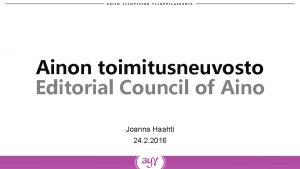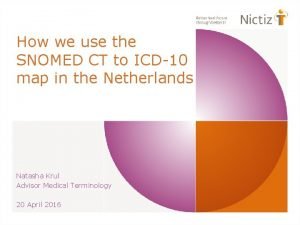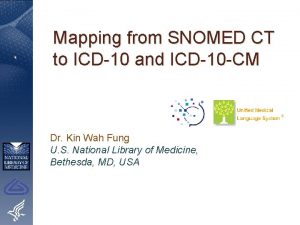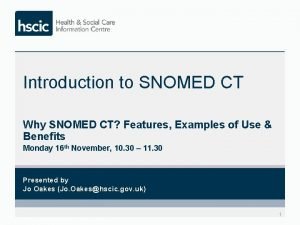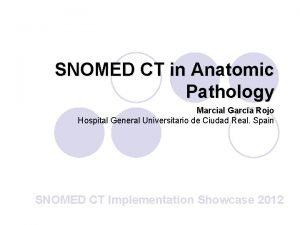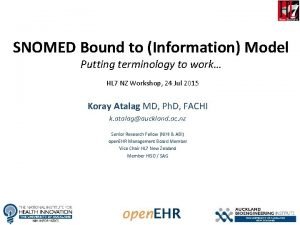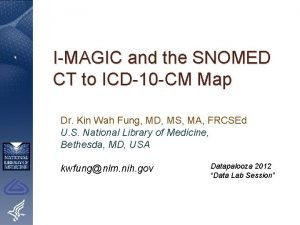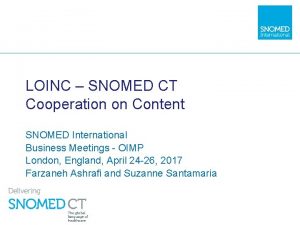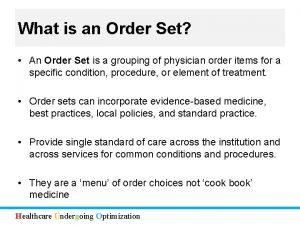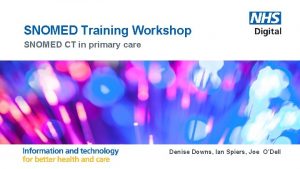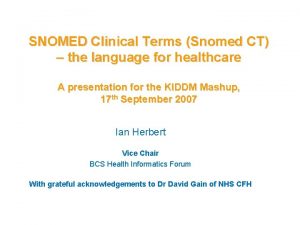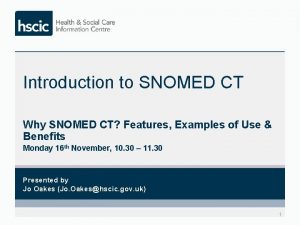SNOMED CT Order Set Strategy SNOMED International Nursing

















- Slides: 17

SNOMED CT® Order Set Strategy SNOMED International Nursing Working Group June 20, 2006 Cyndie Lundberg, RN, BSN Terminology Manager, Nursing © 2005 College of American Pathologists

Outline § Define order sets § Describe order set concept model § Describe order set implementation challenges © 2005 College of American Pathologists

How does one define Order Set? § Ordersets are associated with a clinical state that may contain a list of orders that share a common clinical indication – Standard admission orders – Pre-op cardiac catheterization orders © 2005 College of American Pathologists

How does one define Order Set? § Ordersets are developed to: – Promote patient centric care – Support clinical decision support – Support clinical pathway development – Support CPOE based on business/industry standards © 2005 College of American Pathologists

Types of orders that populate order sets – General ancillary orderables – orders that pass to an ancillary interface system • X-ray right forearm • Colonoscopy with rigid sigmoidoscope through colotomy • Intravenous steroid injection • Complete blood count without differential © 2005 College of American Pathologists

Types of orders that populate order sets – General non-ancillary orderables – orders that do not pass through to an ancillary system • closed drainage wound care • wound treatment education • packing of wound © 2005 College of American Pathologists

Types of orders that populate order sets General non-ancillary orderables orders that consist of communication from one clinician to another or from one clinician to a patient regarding something to be performed – Communication orderables are orders that do not pass through an interface system • Generalized communication orders – e. g. : – – Up ad lib BRP Diet as tolerated Dangle at bedside. etc © 2005 College of American Pathologists

Types of orders that populate order sets General non-ancillary orderables – orders that communicates what needs to be performed. Protocol orderables • e. g. : Skin Care Protocol Concatenated Orders • e. g. : No BP, No Blood Draws No IV sticks on affected arm © 2005 College of American Pathologists

Types of orders that populate order sets General non-ancillary orderables that are communicated from one clinician to another • Complex communication orders: : Criteria based orders – e. g. : IF URINE VOLUME ON STRAIGHT CATHETERIZATION < 30 ML INSERT URINARY CATHETER © 2005 College of American Pathologists

Order. Set Discussions © 2005 College of American Pathologists

Nursing Order Requirements for Integration § What type of nursing orders will be required for data analysis and research? § What are the healthcare integration requirements for nursing orders? © 2005 College of American Pathologists

Should All Orders Be Coded? Does all nursing orderables require codified concepts? – – – Initial patient assessment Admit to NICU Speak directly into the patients best ear Diet as tolerated Notify provider lab results Provide with reorientation, including use of clock, watch, calendar, radio, TV, and newspapers – Sleep apnea protocol © 2005 College of American Pathologists

What Are The Integration Requirements for Nursing Orders? © 2005 College of American Pathologists

Requested Orders: How Should They Be Represented in SNOMED CT? § Clinician orders one orderable to contain multiple meanings tucked into one order – CPM (continuous passive motion machine) application – CPM machine is being monitored throughout the treatment § Question is: Is the SNOMED mapping to mean to apply the machine and monitor the use of the machine? – Continuous passive motion therapy CID 229078009 © 2005 College of American Pathologists

Requested Orders: How Should They Be Represented in SNOMED CT? § Neurovascular Assessment Lower Extremity § Maps via post-coordination to SNOMED CID’s: – Neurovascular assessment CID TBD – Lower limb structure CID 61685007 © 2005 College of American Pathologists

Requested Orders: How Should They Be Represented in SNOMED CT? § Small-Bore Feeding Tube Care § Small-Bore Feeding Tube Discontinue § Small-Bore Feeding Tube Insertion § Maps to SNOMED CID’s? ? ? : – Maintenance of gastrointestinal tract tube CID 384745002 – Nasogastric tube removal CID 81011003? ? ? – Removal of gastrostomy tube CID 90838004? ? – Open insertion of feeding tube into stomach CID 173784007? ? ? © 2005 College of American Pathologists

Questions? Clundbe@cap. org © 2005 College of American Pathologists
 Total set awareness set consideration set
Total set awareness set consideration set Training set validation set test set
Training set validation set test set Via optica
Via optica Joanna haahti
Joanna haahti Icd 10 to snomed
Icd 10 to snomed Snomed ct and icd 10
Snomed ct and icd 10 Snomed soe
Snomed soe Rolandic epilepsy icd 10
Rolandic epilepsy icd 10 Snomed codes pathology
Snomed codes pathology Nzulm
Nzulm Snomed ct and icd 10
Snomed ct and icd 10 Snomed ct foundation course
Snomed ct foundation course Loinc snomed
Loinc snomed Bounded set vs centered set
Bounded set vs centered set Fuzzy theory
Fuzzy theory Crisp set vs fuzzy set
Crisp set vs fuzzy set Crisp set vs fuzzy set
Crisp set vs fuzzy set What is the overlap of data set 1 and data set 2?
What is the overlap of data set 1 and data set 2?



